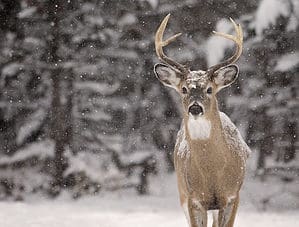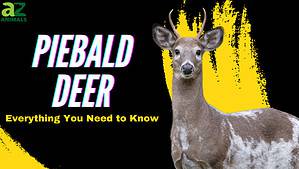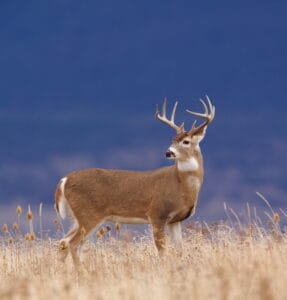Deer season in Utah is open from late summer through the fall, from late August until late October. The Utah Division of Wildlife Resources (DNR) has divided the state into multiple units. It uses these units to manage the deer population. Therefore, regulations and bag limits vary from unit to unit.
To limit the number of deer harvested, the state issues a certain number of deer permits to hunters each year. Hunters must apply for these early in the year or wait to see if any surplus permits are available after the application process. The season dates are similar across units, making hunting a bit simpler.
Multiple special season permits may be applied for in certain units. These special seasons vary in dates and locations.
In this article, we review the various seasons, licenses, and permits that are required for hunting deer in Utah.
Deer Season In Utah: Hunting Licenses, Permits, and Requirements
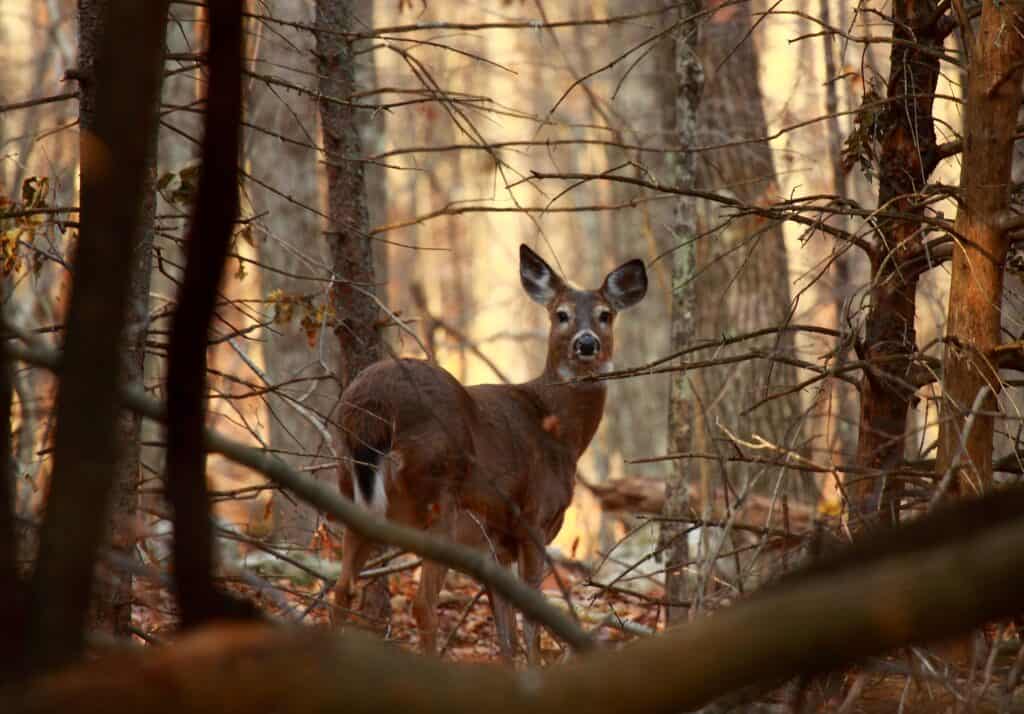
Everyone must obtain a Utah hunting license or a combination license that includes hunting and fishing privileges.
©Gary Gello/Shutterstock.com
To hunt deer in Utah, hunters must be at least 12 years old. Everyone must obtain a Utah hunting license or a combination license that includes hunting and fishing privileges.
Residents of Utah can choose between a license valid for one year or a multi-year license. Resident licenses vary depending on different age groups. Two are for youth hunters, one for ages 13 and under, and the second for ages 14-17. The general adult license is for ages 18-64, and the senior license is for ages 65 and older. The youth and senior licenses cost less than the adult license.
Nonresidents of Utah must also purchase a Utah hunting license. A license from any other state is not valid. Nonresident licenses are similarly available for hunting or a combination of hunting and fishing. They are valid for one year or multiple years.
There are two age groups for nonresident licenses: youth hunters ages 17 and younger and adults 18 and older.
Permits
In addition to a hunting license, hunters must purchase a deer permit. In Utah, there are limited amounts of deer permits. Hunters must apply for them early in the year and are selected through a drawing.
Permits can be for a particular unit, deer species, and antlered or antlerless deer. Permits can be applied for from late May until mid-June. To apply for permits, see the Utah DNR website for guidebooks that contain the application dates, rules, hunt tables, maps, and boundaries. Permits not fully awarded are available over the counter, typically in July.
Hunters can only have one buck deer permit per year. The permit application process can be confusing with the many available options. Therefore, the state website has a whole interactive software that helps you determine which permits you are eligible to apply for. If you’re starting, that’s the easiest way to start the application process.
Hunter’s Education Requirements
In Utah, hunters born after December 31, 1965, must provide proof that they have successfully completed a hunter education course approved by the state before they can purchase a Utah hunting license or deer permit.
In Utah, the hunter education course is available in two formats. One includes an online course followed by an in-person field day. The second is a full in-person course taught by an instructor.
Once you have completed the course, a certificate of completion card will be issued, commonly known in Utah as a “blue card.”
Utah offers a trial hunting program for anyone 12 years old or older who wants to try hunting and still needs to complete the hunter education course. After completing a brief online orientation course and exam, trial hunters will receive a trial hunting authorization number that allows them to hunt. This is possible only if a licensed hunter over 21 accompanies them. This program is open to both residents and non-residents.
The trial authorization number is good for three years, during which the trial hunter can complete the hunter education course at any time. While hunting, the supervising hunter must be able to provide direct, continuous supervision of hunting safety, ethics, and rules. Supervising hunters may only supervise up to two trial hunters at a time.
Types of Deer Seasons in Utah
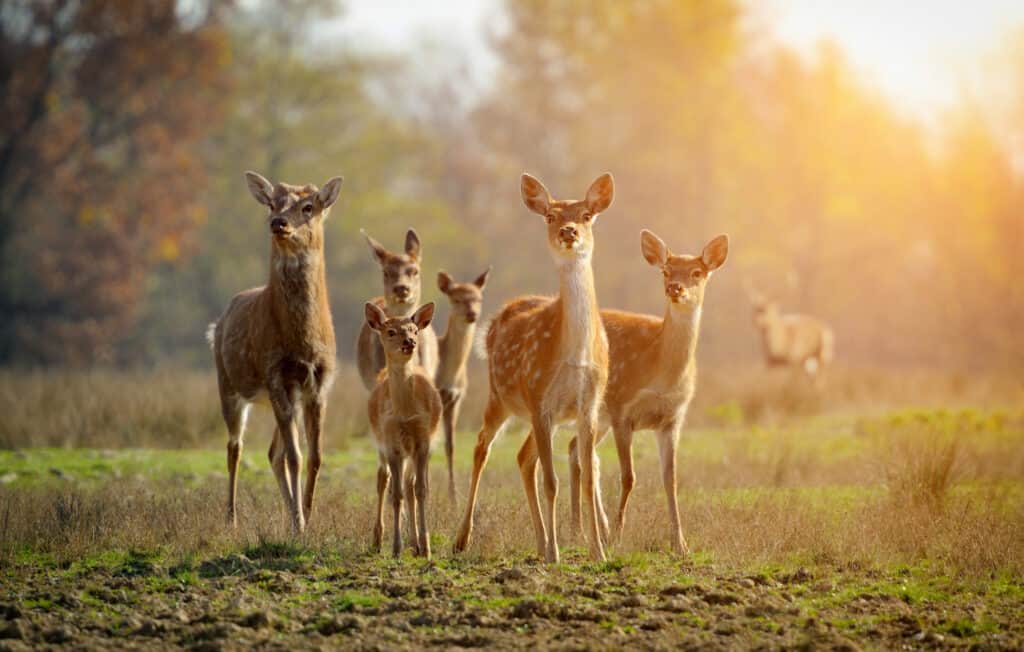
Utah has four general
deer season
types: archery, muzzleloader, “early” any legal weapon (rifle), and any legal weapon (rifle).
©Volodymyr Burdiak/Shutterstock.com
Utah has four general deer season types: archery, muzzleloader, “early” any legal weapon (rifle), and any legal weapon (rifle). The general-season archery buck deer hunt begins on the third Saturday in August. It ends on the third Friday in September.
Note that some areas have an extended archery season until mid-October if you did not take a deer during the regular archery season. The general-season muzzleloader buck deer hunt opens on the last Wednesday in September and is open for eight days.
During the early general season, any-weapon buck deer hunt is open only in specific units on the second Wednesday in October for five days. Finally, during the general season, any-weapon buck deer hunt is available on the fourth Saturday in October for nine days. Utah also has “Premium limited-entry” and “Limited-entry” buck deer hunts held in specific units during a particular season. Hunters can only participate in these hunts if they’ve won their place for these seasons.
Deer Season In Utah: Regulations for Different Seasons
Each general season has specific weapons that are allowed. Weapons during the archery and muzzleloader seasons are restricted. Legal weapon seasons allow more choice but still have limits. The rules for each season type are the following:
Archery Season
If you obtained a general-season archery permit, you may use archery equipment during this season to take one buck deer within the unit listed on your permit. Archery equipment includes longbows, recurve bows, and compound bows. Bows must have a minimum draw weight of 30 pounds at some point during the draw.
Arrows must be at least 20 inches long from the tip of the arrowhead to the tip of the nock. Arrows must have broadheads with two or more sharp-cutting edges at least 7/8 of an inch in diameter. Expanding broadheads are allowed but must have the same characteristics.
Bows with a mechanical device that holds the string at any increment of the draw aren’t allowed. Release mechanisms are allowed if they do not support the bow’s draw weight. Bows may not have a magnifying-aiming device but can have a range-finding device. Crossbows, rifles, shotguns, airguns, muzzleloaders, or draw locks aren’t permitted during the Archery season.
Muzzleloader Season
If you obtained a general-season muzzleloader permit, you may use muzzleloading firearms during this season to take one buck deer within the unit listed on your permit. Muzzleloading firearms must only allow both the powder and bullet to be loaded from the muzzle end of the barrel. The powder and bullet must remain separate.
Muzzleloaders can only have one barrel at least 18 inches long. They cannot fire more than once without reloading. The powder must be black powder or a black powder substitute and cannot contain smokeless powder. Projectiles must be a lead ball or an expanding bullet of at least .40 caliber or larger and 130 grains or heavier.
Muzzleloaders can have open sights, peep sights, or scopes. Other types of firearms and archery equipment are not allowed during this season.
Legal Weapon Season
If you obtained a general-season any-weapon permit, you may use archery equipment, muzzleloaders, rifles, shotguns, handguns, airguns, and crossbows during this season. You’ll be able to take one buck deer within the unit listed on your permit.
Archery equipment and muzzleloaders must follow the requirements listed above. Rifles must fire centerfire cartridges and use expanding-type bullets. Shotguns must be 20 gauge or larger and use slug or buckshot ammunition, with buckshot that is 00 or larger. Handguns must be at least .24 caliber and fire centerfire ammunition with expanding bullets. Handguns may only have a single barrel that is 15 inches or less in length and a single rear handgrip without any fixed or detachable buttstock.
There can be no extension behind the rear grip to steady the handgun, and vertical foregrips are not allowed.
Airguns must be pneumatically powered and charged through a separate device. They may only fire a bolt or arrow at least 16 inches long that travels at least 400 feet per second at the muzzle. The bolt or arrow must have a fixed or expandable broadhead at least 7/8 of an inch at the widest point.
Crossbows must have a minimum draw weight of 125 pounds and have a positive mechanical safety mechanism. Crossbow arrows or bolts have the same requirements as airgun bolts and arrows. Crossbows may have a fixed or variable magnifying scope.
Essential Regulations
Hunters should keep many key rules and regulations in mind while hunting in Utah. This is a partial list of some of the notable ones. Therefore, before hunting, you should review all regulations via the state’s guidebook.
Hunters must wear a minimum of 400 square inches of hunter orange material on their head, chest, and back. There are a few exceptions to this rule. Still, it is generally better to be safe and wear hunter orange anytime hunters with firearms could be in the area.
Hunting hours are from 30 minutes before sunrise to 30 minutes after sunset.
Firearms that are capable of fully automatic fire are not allowed. Firearms with any light-enhancement device or a device that casts a visible beam of light are not allowed. Using a weapon from a vehicle is prohibited upon or across any highway. Shooting at power lines, signs, railroad equipment, or facilities is illegal. Firing a weapon is prohibited within a Utah state park or picnic site, overlook, golf course, boat ramp, or developed beach.
Hunting Zones
Discharging a weapon is not allowed within 600 feet of a dwelling or building or any structure where domestic animals are kept or fed without written permission from the owner or property manager.
Hunting on private land that is Cultivated, posted, or fenced without permission from the landowner is not allowed.
It is illegal to use drones to locate deer from 48 hours before until 48 hours after any deer season. Using bait to attract deer for hunting purposes is not allowed. Using night-vision devices to locate deer from 48 hours before to 48 hours after any season is not allowed. You cannot use a spotlight, headlight, or other artificial light to locate deer while you have a hunting weapon. Using any trail camera to take deer is prohibited between July 31 and Dec 31.
Hunters may not use an airplane, drone, vehicle, or boat to take deer. Dogs may not be used to take, chase, or harass deer. Dogs can be used to aid in the recovery of wounded deer but must remain on a leash.
Party hunting is not allowed; you may not take a deer and report it as being harvested by a hunting partner.
An antlerless deer has no antlers or antlers less than five inches long.
Chronic Wasting Disease in Utah
Chronic Wasting Disease (CWD) is a fatal disease that attacks the nervous system of deer, elk, and moose. Deer infected develop brain lesions, become thin, appear sluggish, have droopy ears, and may salivate excessively. CWD is prevalent in wild deer populations in multiple states and Canadian provinces.
First found in Utah in 2002, as of Sept 28, 2022, 157 mule deer and three elk have tested positive in three different areas within Utah. If you see a deer that appears sick, report it to the nearest division office.
CWD occurs due to small infectious particles called prions. Prion-caused diseases are known as transmissible spongiform encephalopathies (TSE) and are similar to “Mad cow disease.” Infected deer may shed the prions in their urine, feces, and saliva. Other deer may become infected through direct contact or from the prions in the environment.
Prions resist environmental decay and can stay infectious in the soil for years. Because of this, once it is in an area, it is virtually impossible to remove it.
The Utah DNR plans to sample the deer harvested in all units on a five-year rotation, including previously CWD-detected zones. If you harvest a deer in one of the surveillance units, you must bring it to a division check station to collect a small sample for testing. Results are usually available within six to eight weeks. If your deer tests positive, responsibles will contact you directly.
Best Practices
Importing deer, elk, and moose carcasses into Utah from known infection areas is not allowed. You may import only certain parts of the animal. This includes: meat that is boned out and processed, cut, and wrapped, quarters or other portions of meat with no part of the spinal column or head attached, hides with no head attached, skulls and skull plates with antlers attached that have no tissue attached, antlers with no tissue attached, teeth with no tissue, and finished taxidermy heads.
While there has been no evidence that CWD transfers from animals to humans, health officials recommend taking precautions. Wear rubber or latex gloves while field dressing a harvested deer. Do not handle or consume deer that appear sick, and do not consume meat from a deer that tests positive for CWD.
Bone the meat from a harvested deer, and avoid the brain, spinal cord, eyes, spleen, and lymph nodes. Minimize the handling of the deer’s organs and bodily fluids. Wash your hands thoroughly after handling any parts of the deer. Disinfect all knives, tools, and surfaces with 50/50 water and bleach.
Tagging and Transporting
Permits come with deer tags. After taking a deer, you must immediately tag it before moving it or leaving the area. Remove the notches from the deer to indicate the harvest date and sex of the animal. Be careful to remove the correct notch; any notches removed before taking a deer make the tag invalid.
The tag must then be securely attached to the deer in a visible location. The tag must remain with the largest portion of the deer’s meat. After the deer is tagged, you may field dress and transport it.
The head or sex organs must remain attached to the largest portion of the carcass while you are transporting it. During the season, there may be checkpoints where wildlife officers may ask to check your license, permit, and harvested deer.
While Utah does not have a formal game check requirement, if you obtained certain permits, you must complete a harvest survey within 30 days after your hunt ends, even if you did not harvest a deer.
Deer Season In Utah: Fines and Other Penalties
Stealing a deer in Utah can result in fines, loss of hunting privileges, and even jail time. Suppose you trespass and hunt on posted land without the landowner’s permission. In that case, you are guilty of a class B misdemeanor and could lose your license, tag, or permit privileges.
Other license suspensions include violating wildlife law, being convicted, pleading guilty or having no contest, or entering a plea in abeyance or diversion agreement. License suspensions are separate and independent from any criminal prosecution. They are decided by the Utah Division of Wildlife resources regardless of any court’s decision.
License suspensions in Utah include the prohibition to purchase a license in most other states since Utah is a member of the Interstate Wildlife Violator compact. Fines and restitutions can also be up to $8,000 for a deer with a 24-inch antler spread or larger and do not include any court costs or lawyer fees that may be incurred if your case goes to court.
Violations
Some poaching crimes could be considered second-degree felonies, which are punishable by up to 15 years in prison and a $10,000 fine. These convictions typically result from individuals knowingly poaching multiple deer and having multiple criminal charges brought against them. Other crimes are considered misdemeanors but can still result in 90 days to one year in jail and fines from $750 to $2500.
Violating a state wildlife law in Utah is a serious offense. There could be confusion on the available deer permits, so understand what permits you have and where/when it is valid.
Before deer hunting in the state, read and understand the rules and regulations before each season. If you do not live in Utah and are hunting in the state for the first time, take the extra time to understand the rules since they are likely different from your home state.
Up Next
- Deer
- Duck Hunting Season in Massachusetts: Season Dates, Bag Limits, and More
- Duck Hunting Season in Connecticut: Season Dates, Bag Limits, and More
The photo featured at the top of this post is © Tom Reichner/Shutterstock.com
Sources
- Utah.gov, Available here: https://wildlife.utah.gov/hunting/main-hunting-page.html
- Utah.gov, Available here: https://wildlife.utah.gov/guidebooks/2022_field_regs.pdf
- Best Utah Lawyer, Available here: https://www.bestutahlawyer.com/utah-wildlife-game-and-poaching-laws/penalties-and-fines/
Thank you for reading! Have some feedback for us? Contact the AZ Animals editorial team.




